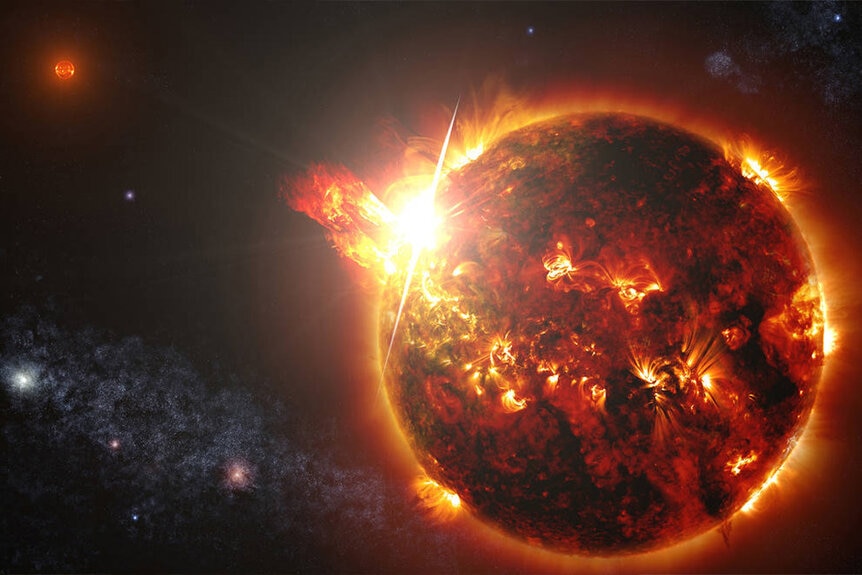Create a free profile to get unlimited access to exclusive videos, sweepstakes, and more!
NASA’s Parker Solar Probe Could Prevent an “Internet Apocalypse”
Planning for the digital end times.

Every eleven years, on average, the Sun reaches the peak of its activity cycle and throws a cosmic hissy fit. The Earth, and the rest of the solar system, must endure a burst of solar flares and coronal mass ejections (CMEs) spewing solar particles and electromagnetic radiation. As long as the Sun’s meltdown is mild to moderate, we should skate through it without too much trouble, but if things go wrong in just the right way, the results could be catastrophic.
That’s what happens in Solar Attack (streaming now on Peacock!) when a large CME, coupled with increased levels of methane in Earth’s atmosphere, threatens to cook the planet in a global extinction-level blaze. In the real world, we’re coming up on solar maximum of solar cycle 25 and the Sun is ramping up the strength and frequency of its CMEs and solar flares. While we haven’t pumped the atmosphere with flammable concentrations of methane, we have put considerable energy toward building communications infrastructure. And that could result in an apocalypse of another kind. Now, data from NASA’s Parker Solar Probe could provide information that might prevent a technological end of the world.
A Powerful Solar Storm Could Trigger an “Internet Apocalypse”
Solar flares and CMEs don’t pose much of a threat to us directly; you don’t have to worry about being struck down by a beam of solar energy or anything. Mostly, the way we experience them is through aurora which light up the night sky near the poles and, during periods of heightened solar activity, closer to the equator. However, they can cause problems for satellites or astronauts in low-Earth orbit, and they can mess with our communications and electrical systems here on the ground.
RELATED: The Earth Just Got Hit With Two Powerful Solar Flares and More Are On the Way
In 1859, an intense geomagnetic storm struck the planet in what has become known as The Carrington Event. The storm occurred a few months before solar maximum of solar cycle 10 and it created incredible aurora which were reported all over the world. It also gut punched humanity’s fledgling communications systems.
When the solar storm struck, telegraph lines all over North America and Europe were impacted. In some cases, sparks flew, fires started, and operators suffered electric shock. The electrical activity in the air was so powerful that some telegraph operators reportedly disconnected battery power to their equipment but were still able to send communications for several hours, using auroral current.
If a similarly powerful solar storm occurred today, it is estimated that we would experience worldwide blackouts and damage to communications systems and electrical grids which could last for months. It’s not the worst imaginable end times scenario, but the impact to production and supply chains for essential materials like food, water, and medications would be dramatically hindered. To call it an "internet apocalypse" severely downplays how bad it would be.
Studying Solar Storms to Prevent Technological Collapse
NASA’s Parker Solar Probe (PSP) launched in 2018 and has spent the last several years flying circles around the Sun, winding its way ever nearer. Recently, astronomers reported that the PSP has flown close enough to the Sun to detect the fine structure of the solar wind, at the point of its creation. Ordinarily, many of those details are lost as the solar wind expands outward into the solar system. It’s sort of like trying to figure out the mechanics of a water stream without looking at the source. The new PSP observations allow astronomers to stick their noses right into the Sun’s hose nozzle, as it were.
RELATED: The First Spark of Life on Earth May Have Come from the Sun
A team of researchers led by Stuart D. Bale, a professor of physics at the University of California, Berkeley, and James Drake from the University of Maryland, found that streams of high-energy particles flowing out of coronal holes are the origin of fast solar winds.
“Winds carry lots of information from the Sun to Earth, so understanding the mechanism behind the Sun’s wind is important for practical reasons on Earth. That’s going to affect our ability to understand how the Sun releases energy and drives geomagnetic storms, which are a threat to our communication networks,” Drake said, in a statement.
A better understanding of where the solar winds come from, how they are generated, and how tne ensuing solar storms impact our planet, could give scientists new tools to protect us against an apocalypse that is probably inevitable on long enough time scales.
We could always take our cues from Solar Attack and fix the problem with nuclear bombs. You can see how well that worked out on Peacock now!



























